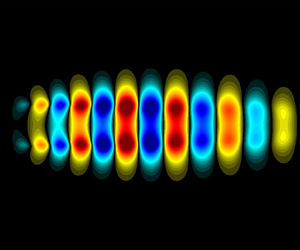Crossref Citations
This article has been cited by the following publications. This list is generated based on data provided by
Crossref.
Nogueira, Petrônio A.S.
and
Edgington-Mitchell, Daniel M.
2021.
Investigation of supersonic twin-jet coupling using spatial linear stability analysis.
Journal of Fluid Mechanics,
Vol. 918,
Issue. ,
Farghadan, Ali
Towne, Aaron
Martini, Eduardo
and
Cavalieri, Andrè
2021.
A randomized time-domain algorithm for efficiently computing resolvent modes.
Pickering, Ethan
Towne, Aaron
Jordan, Peter
and
Colonius, Tim
2021.
Resolvent-based modeling of turbulent jet noise.
The Journal of the Acoustical Society of America,
Vol. 150,
Issue. 4,
p.
2421.
Amaral, Filipe R.
Cavalieri, André V.G.
Martini, Eduardo
Jordan, Peter
and
Towne, Aaron
2021.
Resolvent-based estimation of turbulent channel flow using wall measurements.
Journal of Fluid Mechanics,
Vol. 927,
Issue. ,
Heidt, Liam
Colonius, Tim
Nekkanti, Akhil
Schmdit, Oliver
Maia, Igor
and
Jordan, Peter
2021.
Analysis of forced subsonic jets using spectral proper orthogonal decomposition and resolvent analysis.
Chakrabarti, Surya
Gaitonde, Datta
and
Unnikrishnan, S.
2021.
Representing rectangular jet dynamics through azimuthal Fourier modes.
Physical Review Fluids,
Vol. 6,
Issue. 7,
Wu, Ting
and
He, Guowei
2021.
Space-time energy spectra in turbulent shear flows.
Physical Review Fluids,
Vol. 6,
Issue. 10,
Gareev, L.R.
Zayko, J.S.
Chicherina, A.D.
Trifonov, V.V.
Reshmin, A.I.
and
Vedeneev, V.V.
2022.
Experimental validation of inviscid linear stability theory applied to an axisymmetric jet.
Journal of Fluid Mechanics,
Vol. 934,
Issue. ,
Cavalieri, André V. G.
and
Nogueira, Petrônio A. S.
2022.
Reduced-order Galerkin models of plane Couette flow.
Physical Review Fluids,
Vol. 7,
Issue. 10,
Callaham, Jared L.
Brunton, Steven L.
and
Loiseau, Jean-Christophe
2022.
On the role of nonlinear correlations in reduced-order modelling.
Journal of Fluid Mechanics,
Vol. 938,
Issue. ,
von Saldern, Jakob G. R.
Reumschüssel, Johann Moritz
Kaiser, Thomas L.
Sieber, Moritz
and
Oberleithner, Kilian
2022.
Mean flow data assimilation based on physics-informed neural networks.
Physics of Fluids,
Vol. 34,
Issue. 11,
Lubert, Caroline P.
Gee, Kent L.
and
Tsutsumi, Seiji
2022.
Supersonic jet noise from launch vehicles: 50 years since NASA SP-8072.
The Journal of the Acoustical Society of America,
Vol. 151,
Issue. 2,
p.
752.
Cossu, Carlo
2022.
Onset of large-scale convection in wall-bounded turbulent shear flows.
Journal of Fluid Mechanics,
Vol. 945,
Issue. ,
Franceschini, Lucas
Sipp, Denis
Marquet, Olivier
Moulin, Johann
and
Dandois, Julien
2022.
Identification and reconstruction of high-frequency fluctuations evolving on a low-frequency periodic limit cycle: application to turbulent cylinder flow.
Journal of Fluid Mechanics,
Vol. 942,
Issue. ,
Kuhn, Phoebe
Müller, Jens S.
Knechtel, Sophie
Soria, Julio
and
Oberleithner, Kilian
2022.
Influence of Eddy Viscosity on Linear Modeling of Self-Similar Coherent Structures in the Jet Far Field.
Zhang, Xin-Lei
Xiao, Heng
Wu, Ting
and
He, Guowei
2022.
Acoustic Inversion for Uncertainty Reduction in Reynolds-Averaged Navier–Stokes-Based Jet Noise Prediction.
AIAA Journal,
Vol. 60,
Issue. 4,
p.
2407.
Towne, Aaron
Rigas, Georgios
Kamal, Omar
Pickering, Ethan
and
Colonius, Tim
2022.
Efficient global resolvent analysis via the one-way Navier–Stokes equations.
Journal of Fluid Mechanics,
Vol. 948,
Issue. ,
Yu, Changping
Yuan, Zelong
Qi, Han
Wang, Jianchun
Li, Xinliang
and
Chen, Shiyi
2022.
Kinetic-energy-flux-constrained model using an artificial neural network for large-eddy simulation of compressible wall-bounded turbulence.
Journal of Fluid Mechanics,
Vol. 932,
Issue. ,
Barthel, Benedikt
Gomez, Salvador
and
McKeon, Beverley J.
2022.
Variational formulation of resolvent analysis.
Physical Review Fluids,
Vol. 7,
Issue. 1,
Chen, Xianliang
Cheng, Cheng
Gan, Jianping
and
Fu, Lin
2023.
Study of the linear models in estimating coherent velocity and temperature structures for compressible turbulent channel flows.
Journal of Fluid Mechanics,
Vol. 973,
Issue. ,




